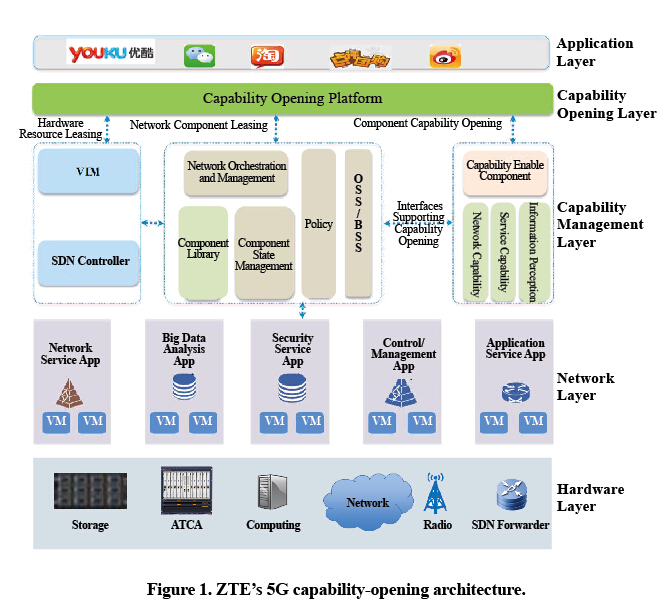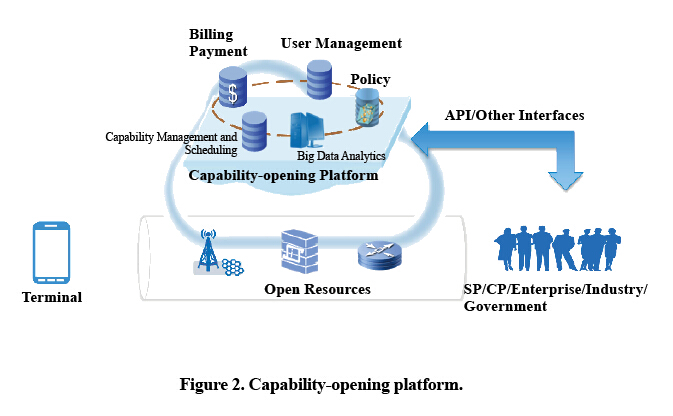Opening Network Capability to Lead 5G Network Operation
Positioning of Network Capability Opening
The first concern of network capability opening is determining what network capability and information can be opened. Increasing capability maximizes multi-parties’ interests and results in win-win situations. After network capability has been increased, users can subscribe user information services with guarantees, while operators can provide differentiated services and launch rich internet applications rapidly. Increasing network capability also facilitates service promotion in the market. What’s more, increasing telecom capability and information motivates operators to better construct, operate, and optimize their networks as well as improve network resource utilization.
Increasing network capability involves increasing the capability of IT hardware and infrastructure, network service processing capability, and network information capability.
IT hardware and infrastructure includes IDC/SDN, CT hardware and infrastructure, including telecom hardware platforms, CPU resources and computing resources, bearer resources with QoS guarantees, and user-based dedicated network resources.
Network service processing capability includes SMS, location services, multi-party conference, rich communication suite (RCS), and billing service.
Network information capability includes the collection and analysis of network information and user information, network policy control, information management, subscription and query, and information security, including user management and authentication, accurate sales, big data consulting, and information security for value-added services. To satisfy customers’ short-term demands, operators need to enhance billing capability, location information, user data, SMS capability, and user management and authentication.
ZTE’s Capability Opening Architecture
ZTE’s capability-opening architecture is an innovative 5G capability opening solution (Fig.1).

ZTE’s 5G capability-opening architecture encompasses the capability opening layer and capability management layer. The capability opening layer invokes network capabilities and provides service capability for the application layer. Its northbound interface is connected to the third-party application layer, and its southbound interface is connected to the capability management layer. The capability management layer adapts capabilities and shields network layer topology from the outside. Its northbound interface is connected to the capability opening layer, and its southbound interface is connected to network layer.
Capability Opening Layer
The capability opening layer involves several functional modules, encompassing capability opening security and reliability, capability resource coordination, pre-billing and post-billing, service platform and environment, and southbound and northbound interface protocol processing. Through this layer, third parties can request the following services from network operators: building a dedicated network environment, leasing proprietary components, opening user and network information, invoking network capability and updating QoS. This layer also has a service platform that can be a self- platform or third-party platform. The service platform is used for accurate sales, games or applications launch and promotion, and content release and subscription. In addition, this layer provides service development environment and test environment in which content providers and individuals can develop and release applications rapidly.
Capability Management Layer
The capability-management layer has several functional modules responsible for service orchestration and modeling based on third-party service requirement, network capability adaptation and encapsulation, network policy generation and execution, information processing, user privacy protection, and northbound and southbound interface protocol processing. This layer adapts and encapsulates capacities according to the capability invocation requirements of the capability opening layer. If any network parameters or user subscription parameter, such as QoS update, are updated this layer generates a corresponding policy and delivers it to the relevant network service APP for execution. If any invocation of user information or network information, this layer converges big data analysis and processing information, network service APP information, and terminal-reported information to presents user and network context information with user privacy protection. In addition, this layer generates different APIs from network capability at the network layer, dedicated network environments or components, infrastructure memory and computing resources in order to increase network capability.
Operation Model Analysis for Increasing Capability
Capability can be increased by network operators or third-party capability operators. Through multiple capability operation models, both operators and CPs/SPs can provide users with better experience and network services.
Package Subscription and Portfolio Charges
One-stop portfolio charges can be adopted by network operators for both individual and enterprise customers. Users can purchase one-stop network capacities that they need through an integrated e-business platform. Individual users can order different bearer QoS levels for various telecom services, and government and enterprise users can order network multi-party conference resource services according to duration.
Platform Provision and Revenue Sharing
Network operators provide service platforms on which the audiences share various platform services, including content, service development and test, user management, and marketing. With the above, users can release chargeable content, promote services, and develop and test application software. Operators collect charges by platform services.
Capability Integration and Cooperation-Benefit
Network operators can integrate all open network capabilities to build a capability-opening platform. Mobile internet providers can request network capabilities according to their service requirements through the platform, and operators provide them with integrated network capability as APIs (Fig. 2).

Win-Win Cooperation
By increasing network capabilities, both network operators and individual users, CPs/SPs, and government and enterprise users can obtain maximum interests from the ecological chain built through capability opening operation. Therefore, network capability opening is a win-win and feasible operation model.
Individual users can have a better experience by subscribing to network capability services. They can purchase QoS resources, subscribe to content services and location-based information services (i.e., transportation information, commodity information and restaurant information), but also release applications developed by themselves and content with personal copyright through the service platform and content release platform to gain profits.
For CPs/SPs and government and enterprise network users, increasing network capability can lower the threshold to use telecom service capabilities. Through the capability opening platform, enterprises can directly utilize the operator’s telecom resources and platforms to customize required telecom and information services, and efficiently use the operator’s infrastructure resources and subscribers and social data to make profits. Moreover, enterprises can achieve service support capabilities such as background billing, user management, and user authorization, which save manpower and operation costs. What’s more, enterprises can build small networks such as CDNs and operate these dedicated networks, and subscribe to sales services, such as game promotion and traffic payment.
Partners work closely with the operator’s own ecosystem by increasing network capability in order to build a good ecological chain and increase their value in the mobile internet era. Increasing service capability saves operators from complex service provisioning and approval process so that they can meet customer’s requirements and improve customer satisfaction. By providing third parties with paid open platform capability, service capability and context information resources, PCC resources, operators create a new profit growth point. Breaking the pipe operation and closed operation models, operators can explore their large-scale core resources and service potential, and creates business value together with partners. Increasing capability enables operators embedding their capabilities in the services that users concern most to attract more customers. In addition, increasing capability enables operators to optimize their resource configurations and increase their competitiveness.